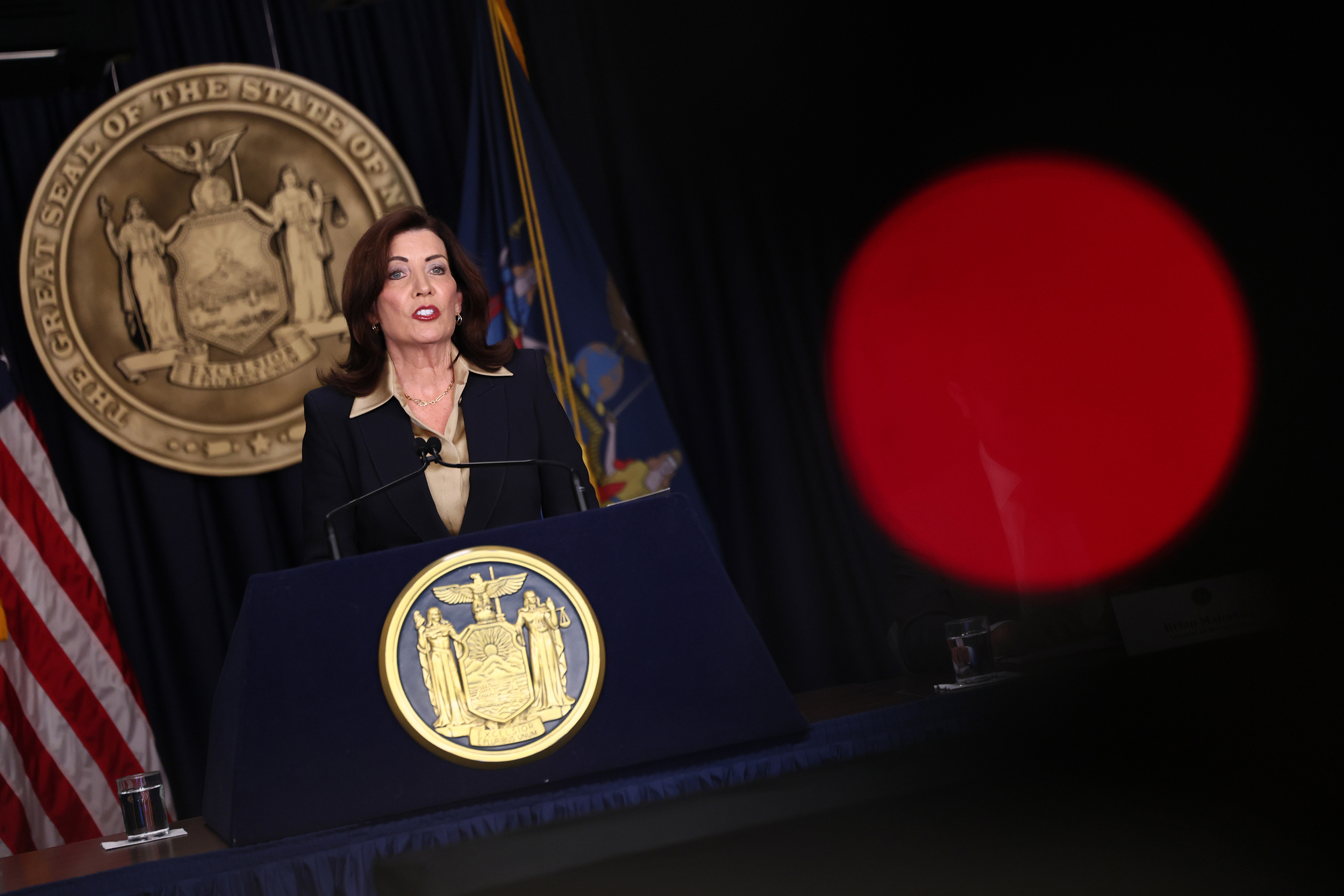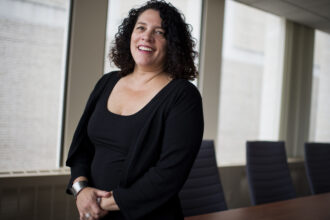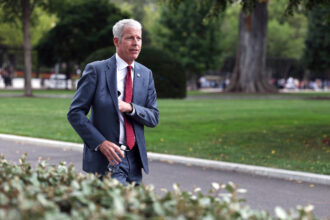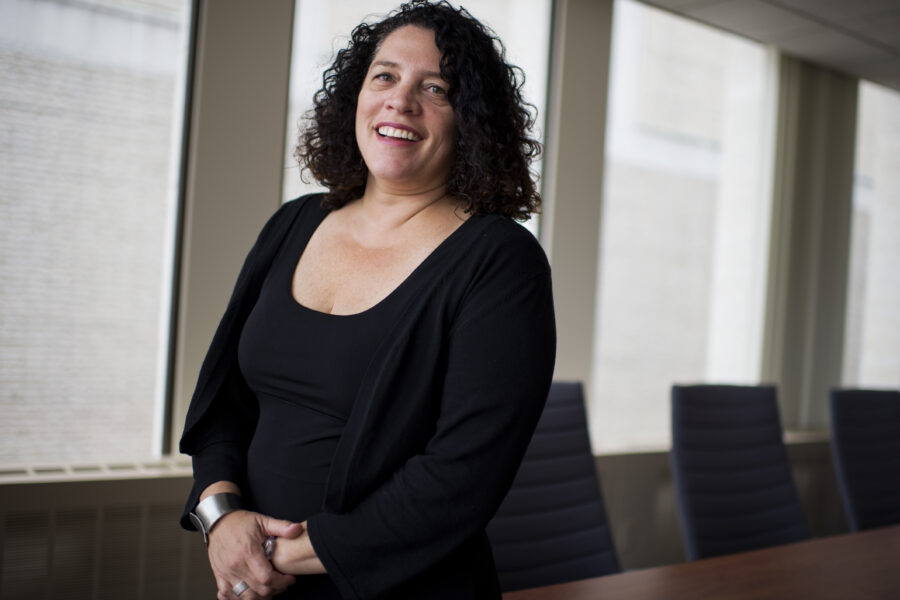During a recent visit to a Long Island power station, U.S. Department of Energy Secretary Chris Wright criticized Biden-era policies that supported the development of renewable energy sources.
“There was a lot of that money allocated under the Biden administration that was to encourage business and utilities to … spend money to make electricity more expensive and less reliable,” Wright said during a press conference.
The next day, the Trump Administration announced the termination of 321 awards, claiming $7.5 billion in cuts for clean energy projects. Inside Climate News recently reported that many of these awards were already past their end date.
Empire Clean Cities, which promotes the advancement of alternative fuels and alternative-fuel vehicles to reduce greenhouse gas emissions, was among the organizations that had its funds cut.
The Manhattan-based nonprofit will lose more than 90 percent of the funds for its $1.7 million award. So far, Empire Clean Cities had received only $162,631 of its award for a project designed to reduce emissions in Hunts Point in the Bronx, according to federal spending data. Largely due to truck traffic, this neighborhood has an annual child asthma hospitalization rate double the citywide average.
“It’s where folks live and work, and so they see every day the impact of truck traffic emissions on their air quality, on their health,” said Joy Gardner, the executive director of Empire Clean Cities. “This was a real opportunity to make a drastic change in just the general quality of life.”
Hunts Point attracts a high volume of freight traffic partly due to its proximity to food centers, including the Hunts Point Food Distribution Center. The city estimates that the center distributes around 4.5 billion pounds of food every year.
Empire Clean Cities is on the cusp of publishing an electrification plan for Hunts Point, with engagement from local businesses, communities and city agencies. The plan would offer a pathway to electrification for vehicles operating in the neighborhood—and subsequently help alleviate the health issues many residents face.
Though Gardner said the plan is likely to still be published, other aspects of the plan could be delayed or may not happen at all. The nonprofit planned to install six fast-charging electric ports in the neighborhoods, for personal and freight vehicles, according to Gardner.
Empire Clean Cities also planned to provide technical assistance to businesses looking to electrify their truck fleets and information sessions for community members who might want to buy an electric vehicle. According to federal spending data, the nonprofit would “undertake an extensive suite of community outreach activities designed to break down the knowledge barriers preventing [electric vehicle] adoption in the neighborhood.”
“It’s really disappointing not to be able to take this over the finish line, especially with just a year left on the grant,” said Gardner. “We would have been able to do a tremendous amount with that.”
In a statement about the grant cancellations, New York Governor Kathy Hochul said “These cuts directly impact local businesses and major companies, putting workers out of jobs, shuttering factories, and slowing our state’s economic progress.”
In response to questions from Inside Climate News, Ken Lovett, Hochul’s senior communications advisor on energy and environment, wrote that the announcement “came as no surprise given the Trump administration’s full-on assault on clean energy.”
The Trump Administration announced the termination of 321 grants on October 2. An Inside Climate News analysis of federal government spending data for the awards found that only 188 were still active, according to their stated end dates, at the end of September.
ICN subtracted money already sent to recipients from the sums obligated to be spent, calculating a total of $4.87 billion in cuts, roughly two-thirds of the dollar amount announced by the Department of Energy.
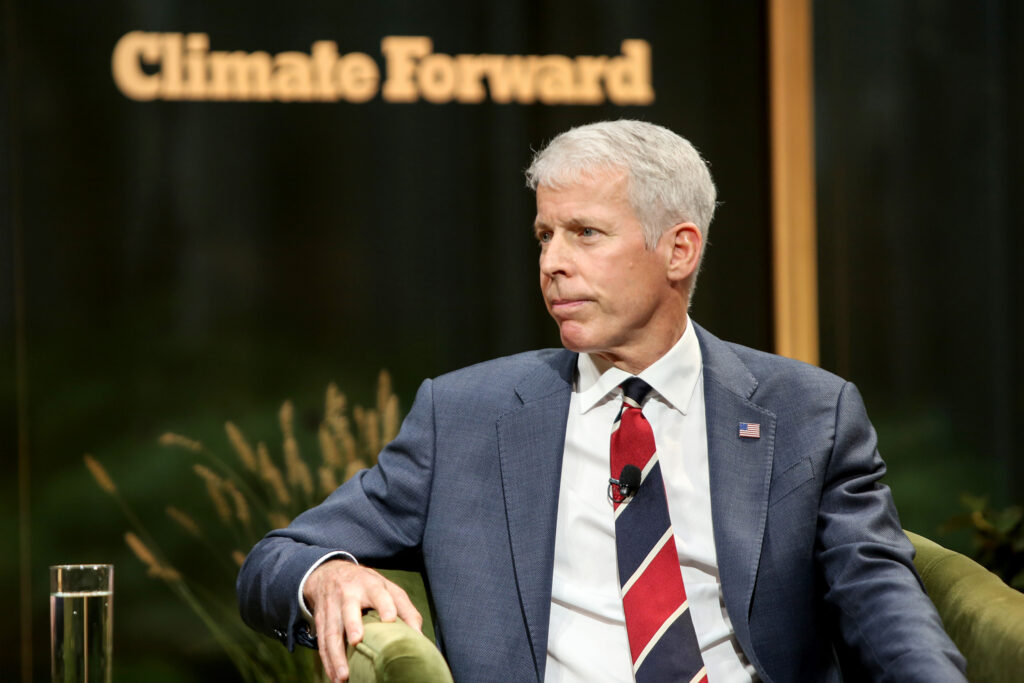
For recipients based in New York state, 20 awards were still active when the Trump administration announced the cuts. After accounting for the money already distributed, the state lost out on about $146 million.
But for Hochul, the grant cuts seem to be just the latest setback to her plans to deliver on the state’s lofty climate goals and address energy concerns. She has recently admitted that New York is unlikely to meet its climate targets, drawing the ire of many residents.
Hochul says she remains committed to reducing emissions in the state and has invested considerable funds toward that goal. She recently allocated $1 billion to clean energy projects and emission-reduction efforts and has directed the state-owned utility, the New York Power Authority, to build at least one new nuclear plant by 2040.
Hochul’s Predicament
At a Brooklyn church in early September, the advocacy group Public Power NY hosted a People’s Hearing for Public Renewables, where officials, environmentalists and a few dozen New York residents discussed the state’s renewable energy plans and expressed disappointment with Hochul’s progress.
“We have a movement behind us that is fighting for something better,” said state senator Jabari Brisport, who represents a district in Brooklyn. “We have a governor who wants to drag her feet.”
New York’s Climate Act requires the state to achieve a 40 percent reduction from 1990 levels in economy-wide greenhouse gas emissions by 2030 and an 85 percent reduction by 2050. The act also requires that 70 percent of the state’s electricity come from renewable sources by 2030.
Residents were advocating for the New York Power Authority to build 15 gigawatts of renewable energy by 2030, which they view as necessary to meet the state’s goal of net-zero emissions from the electricity grid by 2040. Currently, the utility plans to build 7 gigawatts of renewable energy, despite state law requiring it to fill all gaps in electricity generation left by the private sector.
“Hurricane Ida completely destroyed my district,” said former Democratic U.S. Rep. Jamaal Bowman, whose district included White Plains and Yonkers. “We need a governor with human-centered leadership… and if not, we need a new governor.”
Much of the focus on achieving these climate goals has been on electrifying building heating and cooling with heat pumps and moving away from gas systems. In 2023, the state passed the All-Electric Building Act, which mandated that most buildings use electric appliances, and the all-electric standard was written into the state building code in July.
The legislation effectively requires most new buildings to be completely electric—so no gas heating or cooking. A similar law was passed in New York City in 2021.
At a recent press conference, Wright, the federal energy secretary, alluded to the “many productive dialogues” he has had with the governor, and said that two proposed gas pipelines, which would pass through the state and which state officials have rejected in the past, were “already planned” and would “lower the cost of heating.”
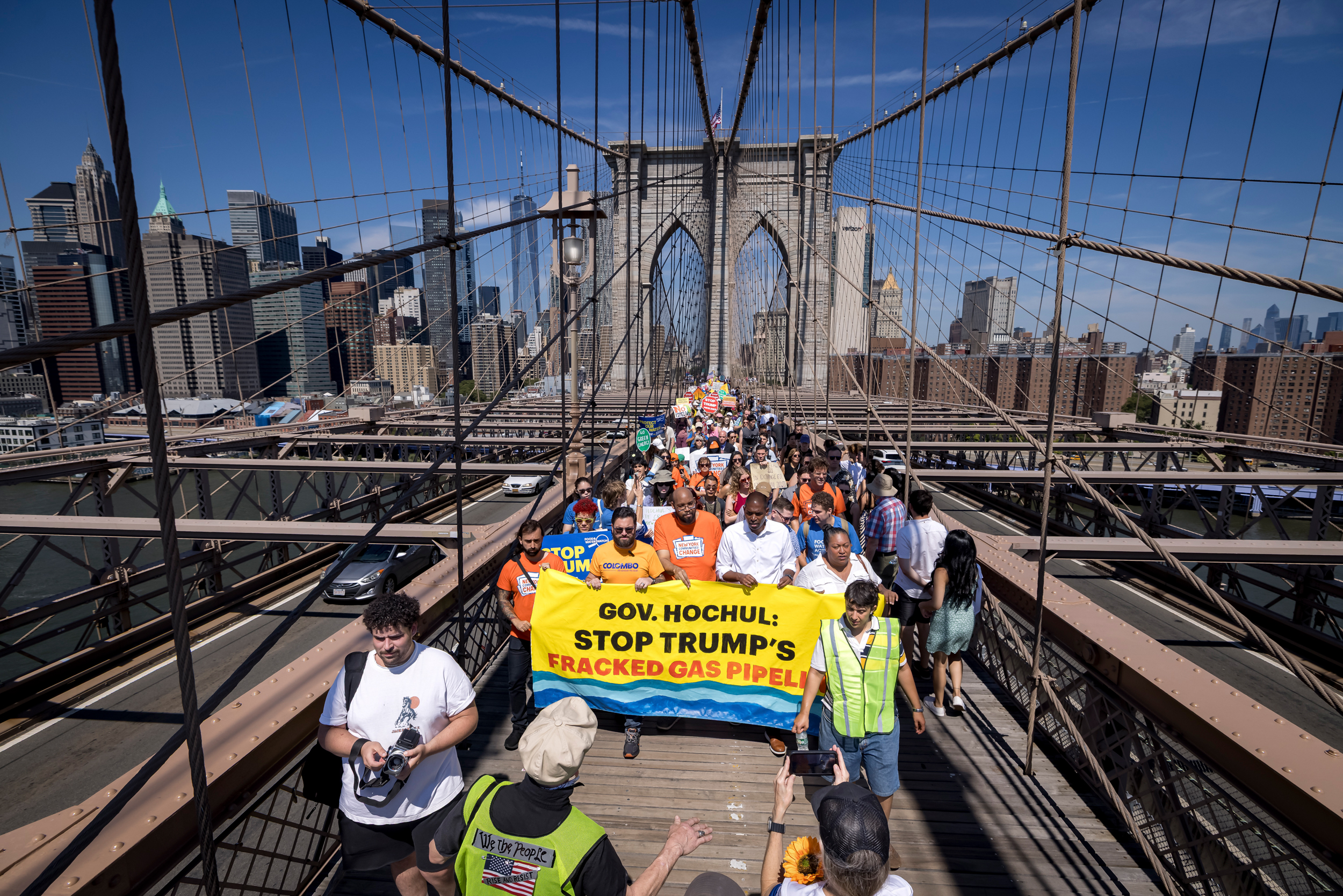
There has been speculation, fueled by a May post on X by Secretary of the Interior Doug Burgum, that Hochul “would move forward on critical pipeline capacity.” The implication was that this was a trade-off for allowing the Empire Wind offshore wind project south of Long Island in the Atlantic Ocean to proceed after the administration halted construction.
Within a month, two previously rejected gas pipelines—the Constitution pipeline and the Northeast Supply Enhancement pipeline, or NESE—entered the regulatory process once again. Hochul has denied that she has made a deal with the White House, but the Trump Administration has said that she “caved” and agreed to allow the pipeline construction, according to Politico’s E&E News.
The Constitution pipeline, which the state rejected in 2016, would run from Pennsylvania’s Marcellus shale fracking sites to upstate New York. The NESE pipeline would extend an existing pipeline, building off the coast of New Jersey and Staten Island to eventually connect with existing pipes in Queens, and add gas infrastructure to Pennsylvania. The state has rejected it three times.
In July, National Grid, the gas utility that serves Staten Island, Long Island and parts of Brooklyn and Queens, added the NESE pipeline to its long-term gas plan as an addendum.
The utility has to file a long-term gas plan as a result of a dispute with former governor Andrew Cuomo. The heart of the 2019 dispute was, ironically, an earlier proposal for the NESE pipeline, which the Department of Environmental Conservation had rejected due to its potential impacts on water quality.
The rejection led to a standoff between the utility and state officials, with National Grid refusing to connect customers to gas lines. The dispute only ended because Cuomo threatened to suspend the utility’s license to operate in the state. In the end, National Grid agreed to periodically file a long-term gas plan for review by the state’s Public Service Commission, which regulates utility rates.
The NESE Pipeline Resurfaces
While reviewing the utility’s plan for the future last month, members of the Public Service Commission found that the NESE project would help the state meet the energy needs of its residents and businesses, particularly in the wake of Winter Storm Elliott in 2022. A report by the Federal Energy Regulator Commission found that some areas of New York were at extreme risk of experiencing gas shutoffs at one point during the storm.
But many New Yorkers were dismayed by the commission’s choice, which has no regulatory authority over the pipeline, but which many believe could signal to the Department of Environmental Conservation that the pipeline is necessary and that it should approve its water permit.
This story is funded by readers like you.
Our nonprofit newsroom provides award-winning climate coverage free of charge and advertising. We rely on donations from readers like you to keep going. Please donate now to support our work.
Donate Now“We are in a week-by-week, hour-by-hour, fight to hold [Hochul] off and keep her from approving this thing,” said Pete Sikora, the climate and inequality campaigns director with New York Communities for Change, about the fight to stop the NESE pipeline.
Several public officials, including Staten Island Borough President Vito Fossella and U.S. House Minority Leader Hakeem Jeffries, spoke out against the pipeline, as did the city of New York. Water quality concerns and fears of substantial rate increases abound.
“The governor is willing to put the law off to the side in order to appease fossil fuel interests, big private business interests… and for New York families to foot the bill for that,” said Kim Fraczek, the executive director of Sane Energy, a nonprofit organization that is advocating for the replacement of gas infrastructure with renewable energy. “Our costs will only increase, and that’s for ratepayers and for businesses.”
A report by the Institute for Energy Economics and Financial Analysis, an energy research think tank, estimated that the pipeline would cost $1.25 billion—almost $200 million more than what National Grid had said—due to construction inflation. Even if National Grid’s figures are correct, ratepayers would suffer a substantial monthly increase.
National Grid has predicted that the pipeline will cost ratepayers an additional $7.50 per month if approved. But it has also argued that the pipeline could help lower electricity bills by reducing the price of natural gas, which powers many of the state’s electricity plants.
Hochul is also experiencing pressure from the other side of the aisle. Secretary Chris Wright recently criticized the state’s Climate Act, which requires the state to have a net-zero emissions electricity grid by 2040, calling it “totally nuts.”
“The longer and more aggressively [net-zero] is pursued, the more you elevate your energy prices and impoverish your citizens,” Wright told journalists at the press conference in Long Island earlier this month. “Let’s build more energy infrastructure to drive down the cost of energy here in New York state, across New England and across our country.”
Whether the Climate Act drives the state’s high energy prices remains a subject of debate. A recent Public Service Commission report found that cost recovery for Climate Act measures accounted for anywhere from 5 to 9.5 percent of a residential customer’s monthly electric bill—but consistently 2 percent or less of their gas bill—in 2024.
Another factor contributing to higher rates has been large-scale improvements in gas infrastructure. Last year, residents in downstate New York experienced rate hikes when National Grid began a $5 billion system upgrade, which included replacing “leak-prone” pipes across the region.
About This Story
Perhaps you noticed: This story, like all the news we publish, is free to read. That’s because Inside Climate News is a 501c3 nonprofit organization. We do not charge a subscription fee, lock our news behind a paywall, or clutter our website with ads. We make our news on climate and the environment freely available to you and anyone who wants it.
That’s not all. We also share our news for free with scores of other media organizations around the country. Many of them can’t afford to do environmental journalism of their own. We’ve built bureaus from coast to coast to report local stories, collaborate with local newsrooms and co-publish articles so that this vital work is shared as widely as possible.
Two of us launched ICN in 2007. Six years later we earned a Pulitzer Prize for National Reporting, and now we run the oldest and largest dedicated climate newsroom in the nation. We tell the story in all its complexity. We hold polluters accountable. We expose environmental injustice. We debunk misinformation. We scrutinize solutions and inspire action.
Donations from readers like you fund every aspect of what we do. If you don’t already, will you support our ongoing work, our reporting on the biggest crisis facing our planet, and help us reach even more readers in more places?
Please take a moment to make a tax-deductible donation. Every one of them makes a difference.
Thank you,


